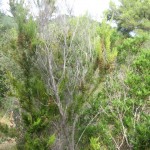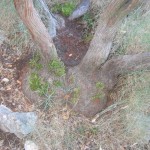Why briar is the “best” pipe wood?
Written on: Sat Nov 20, 2010 by Sasquatch
Source: Pipe Maker’s Forum
I have noticed a large number of people interested in experimenting with woods that are perhaps more readily available than briar, or perhaps less expensive. I am going to try to summarize the reasons that this is by and large a waste of time and money, if the intent is to someday make a nice briar pipe. If your intent is to make weird pipes out of weird materials, I cannot quarrel.
Most woods have a linear grain structure, and this is also the strong axis of the wood. If you cut a 1/2″ off a 2×4, you can easily take the cutoff and break it into 10 pieces. If you take a piece of wood a 1/2″ thick with the grain running longways, you won’t be able to break it at all. So this is the first reason that other woods are inferior to briar: briar’s grain is very tight and much less linear than most other woods. It is also very strong. What this means is that when you shape a briar pipe, you don’t have to worry about the stem snapping off if you get the grain wrong, and on a maple/walnut/pine/whatever pipe this is a real concern. (And if you run the grain “up” the stem with these other woods, you’ll find that the mortise cracks because of the wet/dry cycling).
Briar is almost immune to moisture, it changes much less than most woods, and much more slowly. Woods like maple are very susceptible to cracking from wet/dry cycling, particularly with the application of heat. Pipes are a very very demanding application for wood.
So briar is both stronger, more stable, and less prone to damage from the very types of treatment that a pipe naturally undergoes, than any “regular” wood.
On top of this, briar blocks are treated in a way that no other wood is. They are boiled to remove crappy tasting resins, and then dried very thorougly. So when you get your briar block, it’s ready to become a pipe. It’s dry. It’s clean. When you drill the mortise, it’s not going to change size overnight as the wood shrinks. This treatment also makes briar taste very neutral when you smoke it. It’s not full of bad tasting oils, and most other woods are.
A lot of woods, particularly african woods, are full of nasty oils and resins. Any woodworker who has had a Wenge sliver will tell you that it feels like a bee sting because the wood is literally full of poison. This is not good candidate pipe wood – heating up a bowl full of oils that are nasty (and are allergy sensitizers) is not a real bright idea imho.
Most woods will wick tars away and absorb all the excess moisture as you smoke. This makes for a “great smoker” except that after 20 bowls or so, you’ll see the tar on the outside of the bowl, but only on endgrain. Very ugly. Briar pipes don’t do that.
Likewise, most woods are quite happy to burn right around the temperature that your tobacco is burning, and briar is not.
So we make pipes from briar not because we are snobs, but because time has shown that it is a very suitable material for the purposes we are putting it to. It doesn’t burn, it doesn’t change size, it doesn’t wick, it tastes fine, it’s not ultra-expensive (find me a block of Snakewood, why dontcha?). And it’s pretty on top of all this.
So as you root around through the manzanita burls at Home Depot, or think to yourself, “wow, with just 20 dollars, I can make thrity five pipes from this cedar post”, do yourself a favor and go buy a few pieces of briar. There is so little similarity between briar and other woods that “practicing” on other woods amounts to teaching yourself skills that do not transfer to briar.
So the answer to “Can I make a pipe out of __________ wood?” is “Yes you can, but it won’t be as good as briar for a dozen important reasons.”






